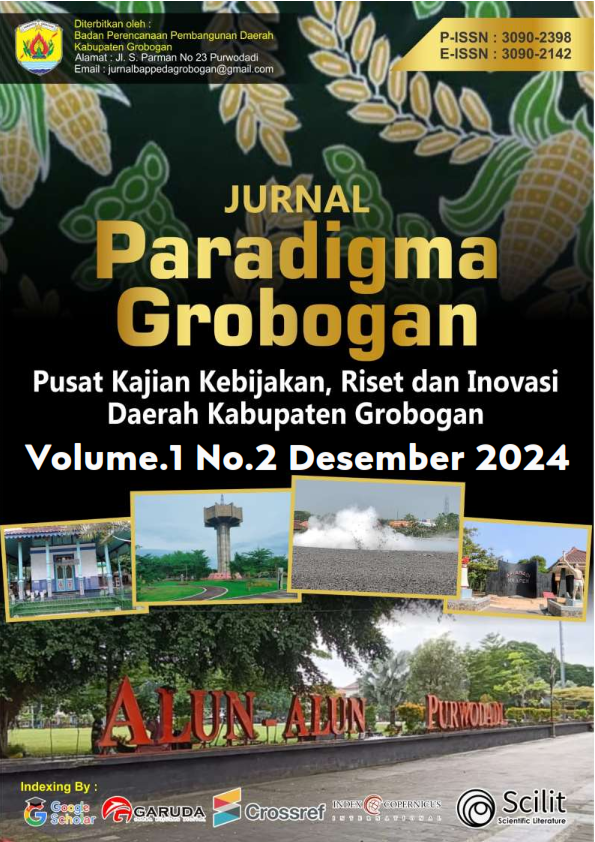Strategi Narasi untuk Penguatan Warisan Budaya dan Alam: Studi Perbandingan City Branding Cappadocia dan Grobogan
DOI:
https://doi.org/10.58684/paradigma.v2i1.52Keywords:
city branding, storytelling, heritage, Cappadocia, Grobogan, geoheritage, sustainable tourismAbstract
This research aims to analyze storytelling strategies for strengthening cultural and natural heritage-based city branding, through a comparative study of Cappadocia, Turkey and Grobogan Regency, Indonesia. Cappadocia is renowned for successfully leveraging geological and cultural heritage through strong visual narratives and unique tourist experiences, while Grobogan holds geoheritage potential such as the Sukolilo Karst, dolinas, and local cultural sites that remain underutilized. This study applies a qualitative method combining literature review, field observation, and key informant interviews. The findings reveal that visual narrative elements, community participation, and local myth packaging are crucial for reinforcing destination identity. This research proposes adaptive strategies to develop Grobogan’s city branding through authentic and sustainable storytelling approaches.
References
Abrahamson, C. (1998). Storytelling as a Pedagogical Tool in Higher Education.
Andrews, D. H., Hull, T. D., & Donahue, J. A. (2009). Storytelling as an Instructional Method: Definitions and Research Ques tions. Interdisciplinary Journal of Problem-Based Learning, 3(2). Crossref. https://doi.org/10.7771/1541-5015.1063
Annelies, K. (2016). Researchdag Hanze University of Applied Sciences.
Ansori, C., Raharjo, P. D., & Fariji, M. A. (2021). Mapping of Karangsambung—Karangbolong Geopark, as an Effort to Manag e Geoheritage in Kebumen Regency. IOP Conference Series: Earth and Environmental Science, 887(1), 012029. Crossref. https://doi.org/10.1088/1755-1315/887/1/012029
Ansori, C., Setiawan, N. I., Warmada, I. W., & Yogaswara, H. (2022). Identification of geodiversity and evaluation of geosites to determine geopark themes of the Karangsambung-Karangbolong National Geopark, Ke bumen, Indonesia. International Journal of Geoheritage and Parks, 10(1), 1–15. Crossref. https://doi.org/10.1016/j.ijgeop.2022.01.001
Atcı, E. (2024). KAPPADOKİA’NIN İKLİM YAPISININ BÖLGENİN SOSYO-EKONOMİK YAPISINA ETKİSİ. Akademik Tarih ve Araştırmalar Dergisi, 7(11), 95–108. Crossref. https://doi.org/10.56448/ataddergi.1532049
Benjamin. (2016). When Plan A Falls Through: Using a Collective Story Methodology to Con struct a Narrative.
Boje, D., & Rosile, G. A. (2020). Storytelling paradigm method, including types of induction, narrative retrospective, antenarrative prospective, integrative qualitative-quan titative methods, narrative inquiry, and multiplicities. In How to Use Conversational Storytelling Interviews for Your Dissertatio n. Edward Elgar Publishing; Crossref. https://doi.org/10.4337/9781839104183.00008
Cooper, J. E., & Decker, M. J. (2012). Life and Society in Byzantine Cappadocia. Palgrave Macmillan UK; Crossref. https://doi.org/10.1057/9781137029645
Cunsolo Willox, A., Harper, S. L., & Edge, V. L. (2012). Storytelling in a digital age: Digital storytelling as an emerging nar rative method for preserving and promoting indigenous oral wisdom. Qualitative Research, 13(2), 127–147. Crossref. https://doi.org/10.1177/1468794112446105
Daveloose, E. (2021). Door het oog van de naald: Het Cappadocisch Grieks. Handelingen - Koninklijke Zuid-Nederlandse Maatschappij Voor Taal- En Letterkunde En Geschiedenis, 75(1). Crossref. https://doi.org/10.21825/kzm.87027
Dikici, A. A., & Özhancı, E. (2024). Kapadokya Antik Dönem Köylerinde Kırsal Peyzaj Karakter İncelemesi. JENAS Journal of Environmental and Natural Studies, 6(3 (In Honour of Nesrin Algan)), 350–368. Crossref. https://doi.org/10.53472/jenas.1572962
García-Huidobro Munita, R. (2016). La narrativa como método desencadenante y producción teórica en la inv estigación cualitativa. Empiria. Revista de Metodología de Ciencias Sociales, 0(34), 155. Crossref. https://doi.org/10.5944/empiria.34.2016.16526
Gualtieri, L. (2001). Storytelling at a distance. eLearn, 2001(5), 4. Crossref. https://doi.org/10.1145/566970.566979
Hartley, J. (2013). A Trojan Horse in the Citadel of Stories? Cultural Science Journal, 6(1), 71–105. Crossref. https://doi.org/10.5334/csci.58
Hayes, A. (2019). Storytelling: Global Reflections on Narrative. Storytelling: Global Reflections on Narrative. Crossref. https://doi.org/10.1163/9789004396401
Hutabarat, L. F. (2023). Pengembangan Geopark Nasional Indonesia menuju UNESCO Global Geopark sebagai Diplomasi Geotourism Indonesia. Jurnal Ilmiah Hubungan Internasional, 19(1), 94–106. https://doi.org/10.26593/jihi.v19i1.6000.94-106
Kazancı, & Yaşar, S. (2020). Lithology and Field Boundaries in Cappadocia, Turkey.
Mucina, D. D. (2011). Story as Research Methodology. AlterNative: An International Journal of Indigenous Peoples, 7(1), 1–14. Crossref. https://doi.org/10.1177/117718011100700101
Özhancı, E. (2021). Koruma Statüsüne Sahip Kentsel Periferik Peyzajın, Peyzaj Değeri ve Ek oturizm Potansiyeli Açısından Analizi. Adnan Menderes Üniversitesi Ziraat Fakültesi Dergisi, 18(2), 253–265. Crossref. https://doi.org/10.25308/aduziraat.954433
Öztürk, M. Z., Özkan, D., & Şimşek, M. (2019). Kapadokya Bölgesinin Drenaj Özellikleri. Journal of Geography, 0(38), 23–34. Crossref. https://doi.org/10.26650/jgeog2019-0002
Prastistho, B., Umam, Z., & Rahadian, Y. A. (2018). Inventory of geoheritage of the Muria Peninsula to develop geotourism. IOP Conference Series: Earth and Environmental Science, 212, 012046. Crossref. https://doi.org/10.1088/1755-1315/212/1/012046
Rahma, R., Yusiana, L. S., & Gunadi, I. G. A. (2020). Perencanaan kawasan karst sebagai kawasan geowisata di Kabupaten Grobo gan, Jawa Tengah. Jurnal Arsitektur Lansekap, 149. Crossref. https://doi.org/10.24843/jal.2020.v06.i02.p02
Roney. (1996). Storytelling in the Classroom: Some Theoretical Thoughts.
Rooney, Lawlor, & Rohan, E. (2016). Telling Tales: Storytelling as a Methodological Approach in Research.
Setyadi, D. A. (2012). Studi Komparasi Pengelolaan Geopark di Dunia untuk Pengembangan Pengel olaan Kawasan Cagar Alam Geologi Karangsambung. JURNAL PEMBANGUNAN WILAYAH & KOTA, 8(4), 392. Crossref. https://doi.org/10.14710/pwk.v8i4.6496
Sunan, H. L., Purnomo, W. H., Chasanah, N., Sugiyanto, G., Adhiana, T. P., Susilawati, H., Imran, R. A., Gibran, A. K., Suroso, S., Cahyono, T., & Laksono, F. A. T. (2020). Kelayakan Geosite dan Geomorphosite Kawasan Desa Wisata Limbasari seb agai Potensi Geowisata Desa Limbasari. Indonesian Journal of Community Services, 2(2), 109. Crossref. https://doi.org/10.30659/ijocs.2.2.109-117
Tekiner. (2021). Small Hotel Location Selection Problem: The Case of Cappadocia. Advances in Hospitality and Tourism Research (AHTR), 9(2), 368–389. Crossref. https://doi.org/10.30519/ahtr.899626
Tibet, E. E. (2018). The sentient ecology of Cappadocia: Dovecote paintings, pigeons, viney ards, cave dwellers and fairy chimneys. Biodiversity, 19(3–4), 225–236. Crossref. https://doi.org/10.1080/14888386.2018.1546125
Wildani, A., Pasha, C. Y., & Caryoadi, Y. (2024). Kajian Identifikasi Potensi Geoheritage Kabupaten Grobogan | Jurnal Paradigma Grobogan. 1(2). https://jurnal.bappeda.grobogan.go.id/index.php/jbp/article/view/10





